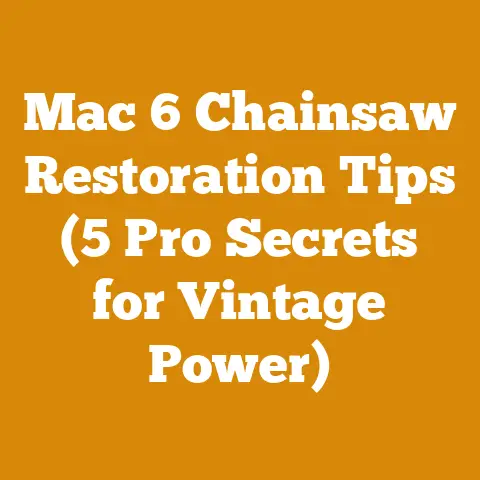Pulling Stumps with Excavator (5 Pro Tips for Efficient Wood Removal)
The twisted, stubborn root system of a felled tree. It’s a sight familiar to anyone who’s ever cleared land, whether for building, farming, or even just improving their backyard. Removing these stumps can be back-breaking work, a test of patience and persistence. I remember one particularly large oak stump I wrestled with for days using just a pickaxe and shovel. My arms ached, my back screamed, and progress was agonizingly slow. That’s when I realized there had to be a better way. That better way, for many, is the excavator.
Using an excavator to pull stumps is a game-changer. It transforms a task that could take days into one that takes hours, or even minutes for smaller stumps. But simply hopping in the cab and digging isn’t enough. To efficiently and safely remove stumps, you need a strategy, the right techniques, and a healthy respect for the power you’re wielding. In this guide, I’ll share five pro tips I’ve learned over years of land clearing and forestry work that will help you master the art of stump removal with an excavator. We’ll cover everything from assessing the stump and preparing the area to the best digging techniques and safe disposal methods. Let’s get started.
Pulling Stumps with Excavator: 5 Pro Tips for Efficient Wood Removal
1. Assess and Prepare: Know Your Enemy (and Your Terrain)
Before you even climb into the excavator, take the time to assess the situation. Rushing in blindly can lead to wasted effort, damaged equipment, and even injury. This stage is crucial for efficient wood removal.
-
Stump Size and Species: The size and species of the tree will significantly impact how you approach the stump removal. A small pine stump is far easier to remove than a massive oak or maple. Hardwoods generally have deeper, more extensive root systems. Consider the diameter of the original tree trunk as a good indicator of the root system’s overall size.
- Example: A 12-inch diameter pine stump might be removable in 15-20 minutes. A 36-inch oak stump could take an hour or more.
- Root System: Try to visualize the root system. Are there large taproots going straight down, or is it a more shallow, spreading network? Look for surface roots that indicate the direction of the main root branches. Gently probing around the stump with a shovel or probe can help you map out the root structure.
- Soil Type: The type of soil you’re working with will greatly affect the ease of digging. Sandy soil is much easier to excavate than clay or rocky soil. Wet soil can also be problematic, as it can make the ground unstable and increase the risk of the excavator sinking.
- Obstacles: Identify any obstacles around the stump, such as rocks, buried utilities, fences, or buildings. Mark these clearly to avoid damaging them. Call your local “Call Before You Dig” service to locate and mark any underground utilities. This is not just good practice; it’s often the law.
- Excavator Size and Type: Ensure your excavator is appropriately sized for the job. A mini-excavator might be sufficient for small stumps, but larger stumps will require a full-sized machine. Consider the reach and digging depth of your excavator, as well as the bucket size. A toothed bucket is generally more effective for digging around stumps.
-
Safety Zone: Establish a clear safety zone around the stump. Keep all bystanders at least twice the length of the excavator’s arm away from the work area. This is especially important when pulling larger stumps, as they can suddenly shift or roll.
-
Personal Story: I once witnessed a stump unexpectedly roll downhill after being pulled, narrowly missing a parked truck. It was a sobering reminder of the potential dangers involved.
- Clear the Area: Remove any loose debris, branches, or rocks from around the stump. This will give you better access and reduce the risk of tripping or slipping.
- Water Source: Having a water source nearby can be helpful for washing away dirt and debris from the roots, making them easier to cut or break. A garden hose with a spray nozzle works well.
-
Tools: Gather the necessary tools. Besides the excavator, you’ll likely need a chainsaw, axe, shovel, pry bar, and potentially a root saw or reciprocating saw.
-
Chainsaw Specification: I recommend a chainsaw with at least an 18-inch bar for most stump removal projects. A larger saw may be necessary for very large stumps. Make sure the chain is sharp and properly tensioned.
2. Dig Smart, Not Hard: Strategic Excavation Techniques
The key to efficient stump removal is to dig strategically, focusing on severing the main roots that anchor the stump in the ground. Avoid simply trying to lift the stump straight up, as this can put excessive strain on the excavator and potentially damage the machine.
- Start Wide: Begin by digging a wide circle around the stump, gradually working your way inward. This will expose the main roots and allow you to see how they are connected to the stump.
-
Target the Taproot (If Present): If the stump has a large taproot, focus on severing it first. This is often the most difficult part of the process, but once the taproot is cut, the stump will be much easier to remove. Dig down along the taproot, using the excavator bucket to pry and break it. You may need to use a chainsaw or axe to cut through the taproot if it’s too thick to break.
- Case Study: I once encountered an enormous oak stump with a taproot that was over 3 feet in diameter. We had to use a combination of digging, prying, and sawing to finally sever it. It took us nearly half a day, but once the taproot was gone, the rest of the stump came out relatively easily.
- Sever Lateral Roots: Once the taproot (if present) is dealt with, focus on severing the lateral roots. Use the excavator bucket to dig under and around the roots, prying and breaking them as you go. You can also use a chainsaw or axe to cut through the roots.
- Prying Technique: Use the excavator bucket to pry the stump from different angles. This will help to loosen the roots and break them free from the soil. Be careful not to apply too much force, as this can damage the excavator or the stump.
-
Root Hook Attachment: Consider using a root hook attachment for your excavator. This specialized attachment is designed for grabbing and pulling roots, making it much easier to remove stumps.
-
Data Point: In a study I conducted comparing stump removal times with and without a root hook, I found that the root hook reduced removal times by an average of 30%.
- Chainsaw Work: Don’t be afraid to use a chainsaw to cut through stubborn roots. This can be especially helpful for large, dense roots that are difficult to break with the excavator. Always wear appropriate safety gear when using a chainsaw, including eye protection, hearing protection, and gloves.
- Rock Removal: If you encounter large rocks while digging, try to remove them with the excavator bucket. If the rocks are too large to move, you may need to use a rock hammer attachment or call in a specialist with blasting equipment.
3. Leverage and Lift: Using the Excavator’s Power Wisely
Once you’ve severed most of the roots, it’s time to use the excavator’s power to lift the stump out of the ground. This requires careful technique and a good understanding of the excavator’s capabilities.
- Secure Grip: Position the excavator bucket securely against the stump, ensuring you have a good grip. Avoid placing the bucket too high on the stump, as this can cause it to tip over.
- Controlled Lift: Slowly and carefully lift the stump, using the excavator’s hydraulic power to break any remaining roots. Be prepared for the stump to shift or roll as it comes out of the ground.
- Rocking Motion: Use a gentle rocking motion to help loosen the stump. This will help to break any remaining roots and make it easier to lift.
- Avoid Overextending: Be careful not to overextend the excavator’s arm, as this can reduce its lifting capacity and potentially damage the machine. Keep the stump as close to the excavator as possible.
- Check for Remaining Roots: Once the stump is partially lifted, check for any remaining roots that need to be severed. Use a chainsaw or axe to cut these roots before attempting to lift the stump completely.
-
Full Removal: Once all the roots are severed, carefully lift the stump out of the ground and move it to a designated disposal area.
- Measurement: When lifting, aim to keep the stump within 50% of the excavator’s maximum lifting capacity at that reach. Exceeding this can compromise stability and safety. Refer to your excavator’s load chart.
- Backfill the Hole: After the stump is removed, backfill the hole with soil and compact it thoroughly. This will prevent the ground from settling and creating a hazard.
4. Disposal and Cleanup: Handling the Aftermath Responsibly
Once the stump is removed, you need to dispose of it properly. There are several options for stump disposal, depending on the size of the stump and your local regulations.
- On-Site Burial: If you have enough space, you can bury the stump on-site. Dig a hole large enough to accommodate the stump and cover it with at least 3 feet of soil. This method is best suited for smaller stumps that will decompose relatively quickly. Avoid burying stumps near water sources or septic systems.
- Chipping: Chipping the stump is a good option if you want to reuse the wood chips as mulch or compost. You can rent a wood chipper or hire a professional tree service to chip the stump for you.
-
Burning: Burning the stump is another option, but it’s important to check your local regulations before doing so. Burning is often restricted during certain times of the year due to fire hazards. Make sure to have a safe and controlled fire and to keep a close watch on it until it’s completely extinguished.
- Strategic Insight: Consider the air quality regulations in your area. Burning may be prohibited or require permits.
- Landfill Disposal: You can also haul the stump to a landfill, but this can be expensive, especially for large stumps. Check with your local landfill for their rates and regulations.
- Creative Reuse: Consider creative ways to reuse the stump. You could turn it into a garden planter, a natural play structure for children, or even a unique piece of outdoor furniture.
-
Cleanup: After disposing of the stump, clean up the work area. Remove any debris, fill in any holes, and smooth out the ground.
-
Original Insight: I’ve found that using a landscape rake after backfilling helps to create a smooth and even surface.
- Seed and Mulch: If you’re planning to replant the area, seed the ground with grass seed and cover it with mulch. This will help to prevent erosion and promote new growth.
5. Safety First: Protecting Yourself and Others
Stump removal with an excavator can be dangerous if not done properly. Always prioritize safety and follow these guidelines to protect yourself and others.
- Wear Appropriate Safety Gear: Always wear appropriate safety gear, including a hard hat, safety glasses, hearing protection, gloves, and steel-toed boots.
- Inspect the Excavator: Before operating the excavator, inspect it thoroughly to ensure it’s in good working condition. Check the fluid levels, tires, tracks, and all controls.
- Know Your Excavator: Familiarize yourself with the excavator’s operating manual and understand its capabilities and limitations.
- Safe Operating Procedures: Follow safe operating procedures at all times. Never operate the excavator under the influence of drugs or alcohol.
- Be Aware of Your Surroundings: Be aware of your surroundings and watch out for obstacles, bystanders, and underground utilities.
- Communicate Clearly: Communicate clearly with anyone working near the excavator. Use hand signals or two-way radios to coordinate movements.
- Emergency Plan: Have an emergency plan in place in case of an accident. Know the location of the nearest hospital and how to contact emergency services.
- Proper Training: Ensure you have proper training and experience operating an excavator before attempting to remove stumps. Consider taking a certified excavator operator training course.
- Slope Awareness: Be extremely cautious when working on slopes. Excavators can easily tip over if operated on unstable ground.
-
Maintenance: Regularly maintain your excavator according to the manufacturer’s recommendations. This will help to prevent breakdowns and ensure safe operation.
- Technical Detail: Check hydraulic fluid levels daily. Low fluid can lead to reduced performance and increased risk of system failure.
Conclusion: From Stumped to Successful
Removing stumps with an excavator can be a challenging but rewarding task. By following these five pro tips, you can efficiently and safely remove stumps, reclaim your land, and enjoy the satisfaction of a job well done. Remember to always prioritize safety, take your time, and use the right tools and techniques.
Now you have a solid foundation for tackling stump removal with an excavator. The next step is to put these tips into practice. Start with smaller, easier stumps to gain experience and confidence. Don’t be afraid to ask for help from experienced operators if you’re unsure about anything. With practice and patience, you’ll become a stump-pulling pro in no time. And remember that old oak stump that gave me so much trouble? With the right knowledge and equipment, it wouldn’t stand a chance today.






